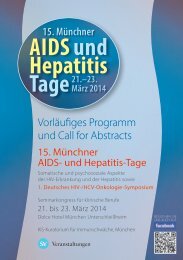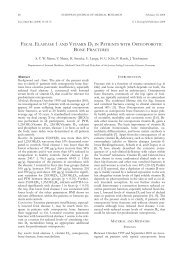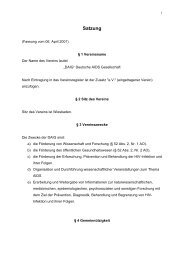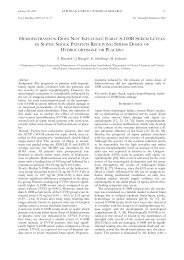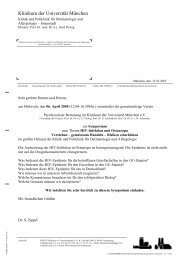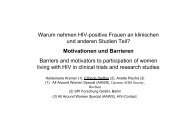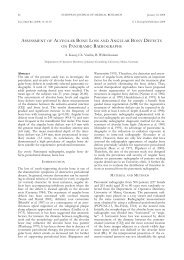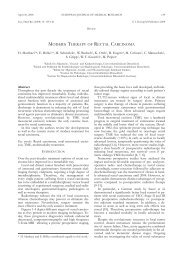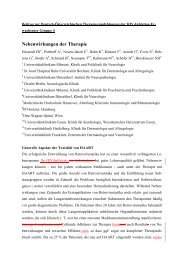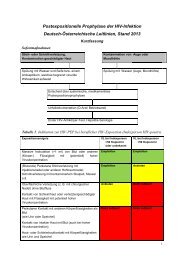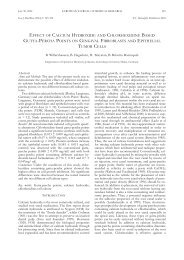European Journal of Medical Research - Deutsche AIDS ...
European Journal of Medical Research - Deutsche AIDS ...
European Journal of Medical Research - Deutsche AIDS ...
You also want an ePaper? Increase the reach of your titles
YUMPU automatically turns print PDFs into web optimized ePapers that Google loves.
120 EUROPEAN JOURNAL OF MEDICAL RESEARCH<br />
June 27, 2007<br />
independent <strong>of</strong> the cells used. In H9 T-cells, increased levels<br />
<strong>of</strong> G to A mutations were detected using HIV-1 NL4-3(-)vif,<br />
but no significant differences in the amount <strong>of</strong> G to A mutations<br />
was observed in regard to the different RTs. However,<br />
increased amount <strong>of</strong> G to A mutations were seen in viral DNA<br />
<strong>of</strong> PBMCs infected with HIV-1 NL4-3(-)vif-M184I compared<br />
with wt- or M184V-RT variants.<br />
Conclusion: High reduction <strong>of</strong> the rate <strong>of</strong> DNA synthesis<br />
(M184I-RT) leads to an increase <strong>of</strong> the amount <strong>of</strong> G to A mutations<br />
induced by APOBEC-3F/-3G whereas moderate reduction<br />
<strong>of</strong> processivity (M184V) has no effect on the amount<br />
<strong>of</strong> G to A mutations suggesting that APOBEC-3F/-G induces<br />
G to A mutations in a time-dependent manner.<br />
F.3 (Poster)<br />
Peptide HIV p24 aa14-22-mediated HLA-E<br />
stabilization alters cross-talk between natural<br />
killer cells and dendritic cells<br />
Schulte D. 1 , Körner C. 1 , Krämer B. 1 , Vogel M. 1 ,<br />
Langhans B. 1 , Nischalke H.D. 1 , Sauerbruch T. 1 ,<br />
Spengler U. 1 , Rockstroh J.K. 1 , Nattermann J. 1<br />
1 Uni-Klinikum Bonn, Medizinische Klinik I, Bonn, Germany<br />
Introduction: Recently, we demonstrated the HIV peptide<br />
p24 aa14-22 (PEP-I) to bind to HLA-E, the natural ligand <strong>of</strong><br />
the inhibiting natural killer (NK) cell receptos NKG2A. Of<br />
note, PEP-I-mediated up-regulation <strong>of</strong> HLA-E resulted in impaired<br />
cytotoxic activity <strong>of</strong> natural killer cells. Here, we<br />
analysed whether this interaction alters cytokine secretion <strong>of</strong><br />
NK cells and affect the maturation and differentiation <strong>of</strong> dendritic<br />
cells.<br />
Methods: NK cells from HIV-infected patients and healthy<br />
donors were co-cultured with HLA-E-transfected K-562 cells<br />
(HLA-E-K562 cells) loaded with and without 10�M PEP-I.<br />
Monocyte-derived dendritic cells (MO-DC) were incubated<br />
with supernatants from these co-cultures and flowcytometrically<br />
analyzed for expression <strong>of</strong> the maturation markers<br />
CD83, MHC class I, CD40 and HLA-DR.<br />
Results: Both in HIV-infected patients and healthy controls<br />
the interaction <strong>of</strong> PEP-I with HLA-E selectively reduced secretion<br />
<strong>of</strong> TNFa and IFNg but enhanced secretion <strong>of</strong> IL-6 in<br />
those NK cells which had been exposed to HLA-E-K562 cells<br />
together with PEP-I. Exposure <strong>of</strong> MO-DC to supernatants<br />
from NK cells stimulated by HLA-E-K562 cells plus PEP-I<br />
resulted in a reduced expression <strong>of</strong> the maturation markers<br />
CD40, MHC class I and HLA-DR as compared to MO-DC exposed<br />
to NK cell supernatants cultured without PEP-I.<br />
Conclusion: Here, we show peptide HIV p24 aa14-22-induced<br />
HLA-E stabilization alters cytokine secretion <strong>of</strong> natural<br />
killer cells thereby affecting the cross-talk between NK cells<br />
and dendritic cells via soluble mediators. Thus, the interaction<br />
between peptide and HLA-E affects further immunoregulatory<br />
functions beyond its direct inhibition <strong>of</strong> NK cell cytolytic<br />
activity.<br />
F.4 (Vortrag)<br />
Characterisation <strong>of</strong> effector memory phenotypes<br />
and CD57-expression on HIV-specific CD8+ T cells<br />
Meyer-Olson D. 1 , Simons B.C. 2 , Conrad J.A. 2 , Barnett L. 3 ,<br />
Lorey S. 3 , Smith R.M. 3 , Schmidt R.E. 1 , Kalams S.A. 3 ,<br />
Kompetenznetz HIV/BMBF<br />
1 Medizinische Hochschule Hannover, Klinische Immunologie,<br />
Hannover, Germany, 2 Vanderbilt University <strong>Medical</strong> Center,<br />
Department <strong>of</strong> Microbiology and Immunology, Nashville,<br />
United States <strong>of</strong> America, 3 Vanderbilt University <strong>Medical</strong><br />
Center, Infectious Diseases Unit, Nashville, United States <strong>of</strong><br />
America<br />
Alterations <strong>of</strong> effector memory phenotype markers such as<br />
CD45RA+/CCR7- and markers associated with terminal<br />
CD8+ T cell differentiation such as CD57 are a hallmark <strong>of</strong><br />
chronic HIV-infection, but the structural and functional basis<br />
<strong>of</strong> these changes remain elusive. Differentiation into effector<br />
memory phenotype CD8+ T cells with expression <strong>of</strong><br />
CD45RA (TemRA) is known to be impaired on HIV-specific<br />
CD8+ T cells and CD45RO-positive (TemRO) HIV-specific<br />
CD8+ T cells are overrepresented in the majority <strong>of</strong> HIVseropositive<br />
subjects. Here, we demonstrate that expansions<br />
<strong>of</strong> terminally differentiated HIV-specific TemRA-phenotype<br />
cells can be infrequently detected in HIV-controllers as well<br />
as in subjects with higher viral loads. Differentiation into<br />
TemRA-phenotype on HIV-specific CD8+ T cells was frequently<br />
restricted to distinct clonotypes within an epitopespecific<br />
T cell receptor (TCR) repertoire. Expression <strong>of</strong> CD57<br />
on TemRA HIV-specific CD8+ T cells was not significantly<br />
increased as compared to HIV-specific TemRO-phenotype<br />
cells but we observed a significant reduction <strong>of</strong> CD57 expression<br />
on HIV-specific TemRA phenotype cells as compared to<br />
unselected CD8+ T cells with a TemRA phenotype. Our data<br />
provide evidence for structural constraints in HIV-specific<br />
CD8+ T cell effector-memory maturation in chronic HIV-infection<br />
with distinct expressions <strong>of</strong> markers associated with<br />
terminal differentiation.<br />
F.5 (Vortrag)<br />
Optimized class C oligodeoxynucleotides (ODN)<br />
support the impaired innate immune response <strong>of</strong><br />
plasmacytoid dendritic cells (PDC) in HIV-infected<br />
patients<br />
Donhauser N. 1 , Helm M. 2 , Schuster P. 1 , Haupt S. 1 ,<br />
Vollmer J. 3 , Schmidt B. 1<br />
1 Virological Institute, Clinical and Molecular Virology,<br />
Universitätsklinikum Erlangen, German National Reference<br />
Centre for Retroviruses, Erlangen, Germany, 2 Praxis Abelein /<br />
Helm, Nürnberg, Germany, 3 Coley Pharmaceutical GmbH,<br />
Langenfeld, Germany<br />
Objective: Human plasmacytoid dendritic cells (PDC) are the<br />
major type I-interferon producing cells upon stimulation with<br />
CpG oligodeoxynucleotides (ODNs). Patients with human immunodeficiency<br />
virus (HIV) infection show a decrease in<br />
PDC numbers and a functional impairment. CpG ODNs appear<br />
to be attractive therapeutics in HIV, because they may<br />
enhance the impaired innate immune response, which may<br />
subsequently contribute to the control <strong>of</strong> virus replication.<br />
Methods: The following study was performed using peripheral<br />
blood mononuclear cells (PBMC) obtained from 15 untreated<br />
HIV-infected patients with CD4+ cell counts between 152



